Riso Printing, Research and Crit.
Today we sat in the Computer suite until it was time to go and work with Jim to finish off a Riso Print that we began thinking about last week.
We discussed how we would spend the time waiting and then carried out some research on the PCs in the room. Alice gave us a list of Tasks that need to be completed over the next week.
Tasks:
1. Write a 600 word reflection on your Riso-printing experience using Gibbs’ Reflective Cycle model (See Semester 1, Week 8 PowerPoint for a refresher).
2. Revisit your Semester 1 formative review feedback – have you responded to the suggestions made? Is your sketchbook up to date? If not, create an action plan to complete any missing work before the next review point.
3. Identify your essay question / argument and continue your independent research to gather sources to support it.
4. Plan and conduct your next shoot / practical experiment.
For Task 1 I’ve already written the start of it in this post but will continue with what we did with Jim and I’ll use the Gibbs Reflective Cycle to discuss how it goes, that will be in the next post.
Task 2 means I need to to look back at my feedback and see what I need to have improved before the next review. Each of the following Learning Objectives are extracts from my feedback and I’ll append each with some updates as to how I’ve altered my work or what I think still needs to change.
LO1: .”...extensive material experimentation and alternative processes. You are pushing your project on weekly which is enabling you to refine methods and analyse the effects generated. Conceptually, you need to begin considering the impact of these experiments – what do they say? What do you want them to say? “
Still an issue for me sometimes, the experiments I’m carrying out in terms of weaving, print alteration and even the recent negative damage experiments have left me with some big questions as to why I’m doing them and what I get out of them. There are some answers in previous posts in this journal and I strongly suspect that each has a different reason. I’m not super worked up about any particular cause so don’t have really strong feelings about any single issue but the weaving of images feels to me like I’m trying to create a piece of work that is a compromise, carefully constructed with no arguing. This is in opposition to the way I see people around the world behaving on a regular basis, party politics, gender politics, religion, monarchists, republicans, race discussions at the moment seem to be hijacked some of the time by groups of people who are not prepared to discuss the issue like sensible adults, instead resorting to polemic arguments in which nobody tries to have empathy and see the other side’s view of the matter. the joining of day/night images for me connects with my desire to join left wing and right wing people together, almost knocking their heads together to make them see sens and have empathy for each other. We’re trying to exist on the planet at the same time, lets all just get along.
The alteration of the prints using paper folding or other methods is a distortion of the images to me, either to prevent someone seeing the true image or to disguise or obfuscate it and make it something that a viewer needs to put work into in order to read it. It’s about distortion of reality and the memories of bygone days being printed upon the fabric of contemporary society. (that sounds like it was written by ChatGPT but I really did come up with that, not sure if that’s a good thing or a bad thing)
The negative damage I recently carried out, by dropping my camera in a puddle, then continuing to process the film and create prints from it, resulted in some strange damage to the negatives and the output I think reflects my memories of the places I was shooting and how their presence in my memory are not the same as they once were, they’ve been diluted by time and overwriting memories. A good example is a couple of the damaged pictures being my old childhood home in the three storey houses, when I was small the rooms were massive with high ceilings, now I’m 6ft2in tall the overall impression of the house has changed to suit my scale. If i’m honest it’s all a little underwhelming. The car park behind the houses that had few cars there when I was five to ten years old, we called the “Square”. It’s tiny today and cramped with workman’s vans, lorries, wheelie bins and trailers. Everything felt so small and it’s like my memories are being rinsed with a bath of truth and understanding.
LO2: “In order to develop your concept further for your yearlong project, you need to push your independent research much more. This will help you to contextualise your own work and consider why others may have used similar methods and materials. Have a look at the work of Alma Haser, who works with paper-folding techniques, collage and mixed media.“
My independent research is growing, I’m picking up books like On Photography by Susan Sontag, Concretoopia by John Grindrod, Face by William Ewing, Brutalist Britain by Elain Harwood, How photography became contemporary art by Andy Grundberg and journal articles, magazine columns, videos, documentaries etc. Some of these make it into my sketchbook and some will end up on the blog, as well as in the reference list for my essay.
LO3: “To strengthen your work towards this learning outcome further, try to record more of your tutorials on Tuesdays to showcase your communication with others as well as any conversations you have with peers, other members of staff, and other people you share your work with.“
This was a slight misunderstanding as I hadn’t made it clear that my tutorials and seminars were also documented on this online reflective journal. We’d looked at the sketchbook but I’d neglected to mention this wordpress blog contained much of my reflection.
LO4: “You reflect regularly on what has been discussed in class, your own practical work and trips you have attended.“
Again, this blog and my sketchbook show updates on visits to galleries and exhibitions as well as the valuable conversations I have with my peers, lecturers and other influential artists. The work I’ve continued to document in this blog since the review keeps up the pace sufficiently.
LO5: …..Increasing your focus on research is important moving forwards to help inform your own work.
Since the review I’ve spent much more time reviewing documents and information that can be used as research. As part of looking into “Tin Town” i’ve been consulting the Shropshire Archives, online resources for house construction, house sales websites etc. For my work on “car park” related images I’ve also been investigating the archives, youtube videos and talking to people about their experiences.
Looking at all of the above learning objectives, I still need to continue researching and better documenting it, with lists of sources and important information gleaned from them. The more I can show I’ve been researching the better. Some positive researching was done this week and can be seen in the information below.
Task 3: What is my essay question?
This is a tricky one, I’ve been leaning more towards my photography of old buildings either historical or from my childhood. This is where I spent much of my research time today studying info for this topic. There are other questions below that Ive brainstormed too and the act of getting these written down is helping me to form my own selection of the actual work that I want to include in the essay.
Old Places
- Does making photographs of locations from my past aid or hinder my memory?
- Does it bring to mind old experiences?
- Does it bring to mind memories of friends?
- Does it colour my memory of what life was like then?
- Are photos today good reflections of how it was in my childhood?
- Do I make up memories to fit photographs?
- Is it useful to have these images?
- Am I using photography to make sense of my early life?
https://www.digitalcameraworld.com/news/its-official-looking-at-old-photos-is-more-relaxing-than-meditating Information on how ooking at photographs may be good for mental health.
https://www.wyjs.org.uk/media/1310/guide-8.pdf might be useful for car park and tin town with information on how to practically document historic buildings.
https://www.linkedin.com/pulse/historic-preservation-month-why-photography-matters-tool-wyllie Information on why we should make images of buildings in our communities.
https://historicengland.org.uk/images-books/publications/photographing-historic-buildings/ Technical reasons and methods for making photographic records of historic and interesting buildings.
https://www.tandfonline.com/doi/full/10.1080/17514517.2021.1927369 Journal article about how photography is useful in documenting indigenous lands and the environments.
https://www.bbc.co.uk/news/world-europe-64513310 a BBC News article demonstrating importance of documenting history and provenance in Kandinsky painting on wall in someone’s house before Nazis forced the sale.
Historical landscape repeat photography as a tool for land use change research (tandfonline.com) Importance of Repeat photography, revisiting spot at regular time intervals to document change.
Crossed gazes over an old city: photography and the ‘Experientiation’ of a heritage place (tandfonline.com) Photos of porto heritage, taken by tourists, residents, marketers, councils.
Distressing Negatives/Prints
- Why does damaging a roll of exposed film tell me more about the photos on the roll?
- Is the damage relevant to the subject?
- Is it catharsis?
- Is it rebellious , when I’ve got an innate wish to make sure everything is perfect as possible?
- What does the damage remind me of?
- Does it represent that images in my mid can be altered or stained by experiences after the image was made?
Weaving
- What do the results of a weaving exercise tell me about myself?
- Is it a desire to meet in the middle?
- To average out situations in a compromise?
- To blur the boundaries?
- To confuse and disrupt thought patterns?
Task Four – Plan and Conduct a Shoot.
I had a plan to carry out a follow up shoot for the work discussed with Niki a couple of weeks ago. The plan was to revisit the bus shelters that should have been upgraded with my Bronica ETRS and B&W ilm to create some 645 images as well as my Canon 5D MkIV in case there were any issues with the film camera.
I revisited the same spots as documented in the timetable provided by Stuart in the Town Council and this time it was afternoon before the sun started setting on Saturday. I managed to capture the shelters that had been changed this week as well as a couple of others that hold relevant memories for me too.
The new bus shelters were easy enough to photograph and document the environment around them but with more people around I found that people were a little suspicious of my motives. One family suggested I must have been with the council documenting the changeover. Another couple of teenagers on a single bmx simply shouted out “PERV” as they rode through my composed shot.
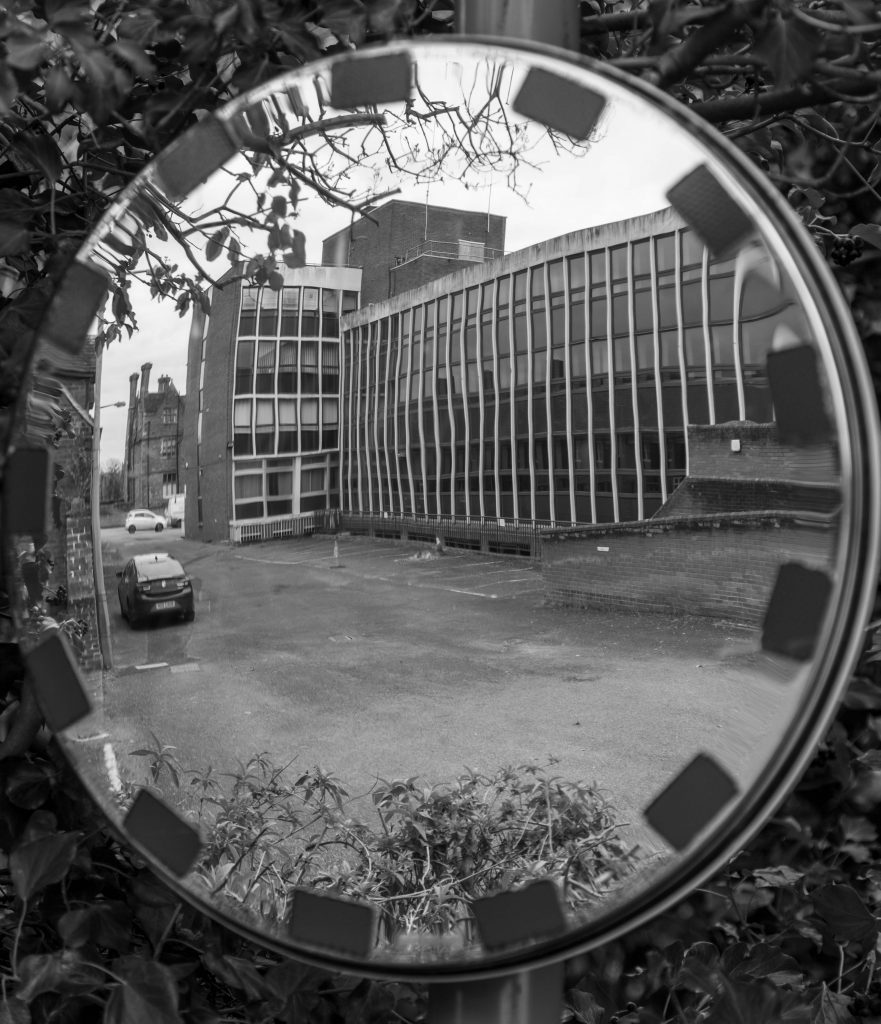
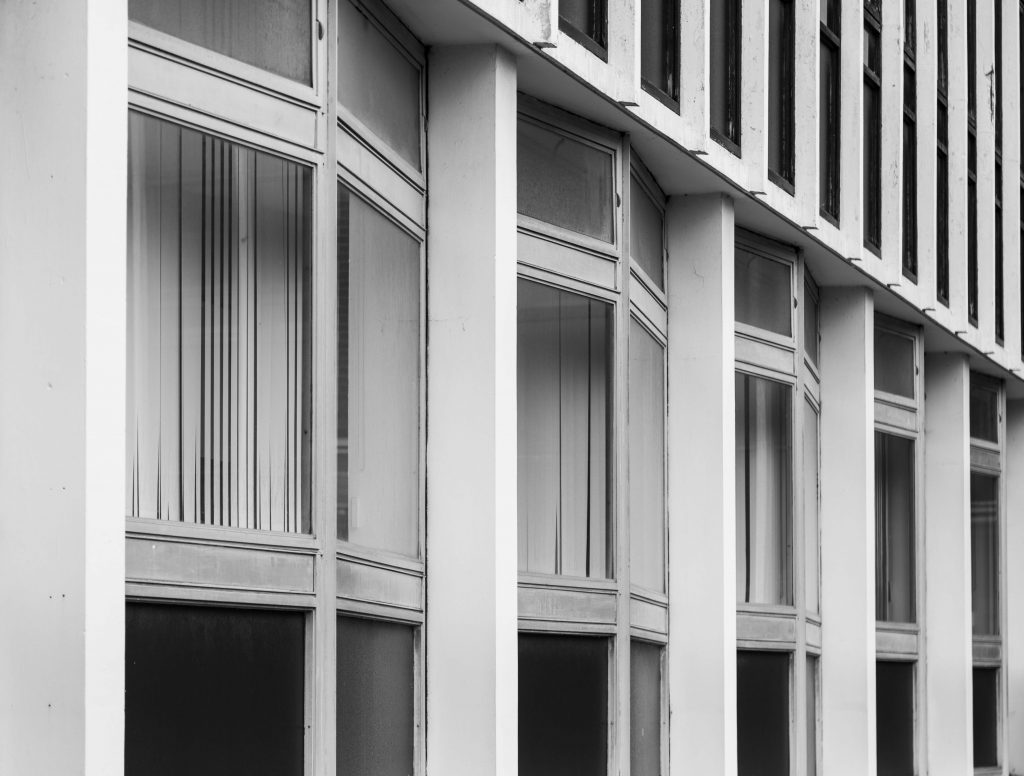
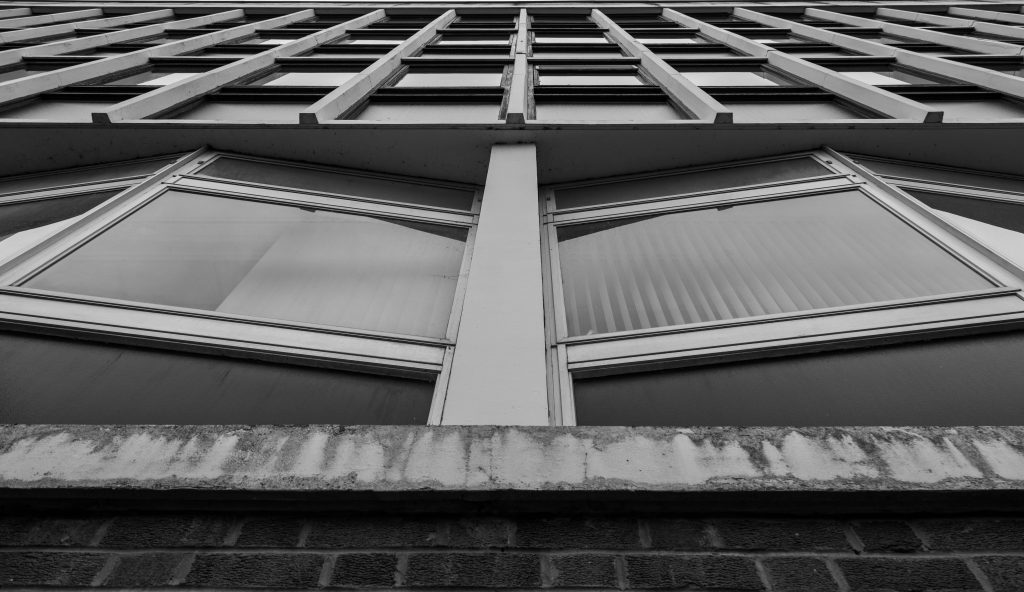
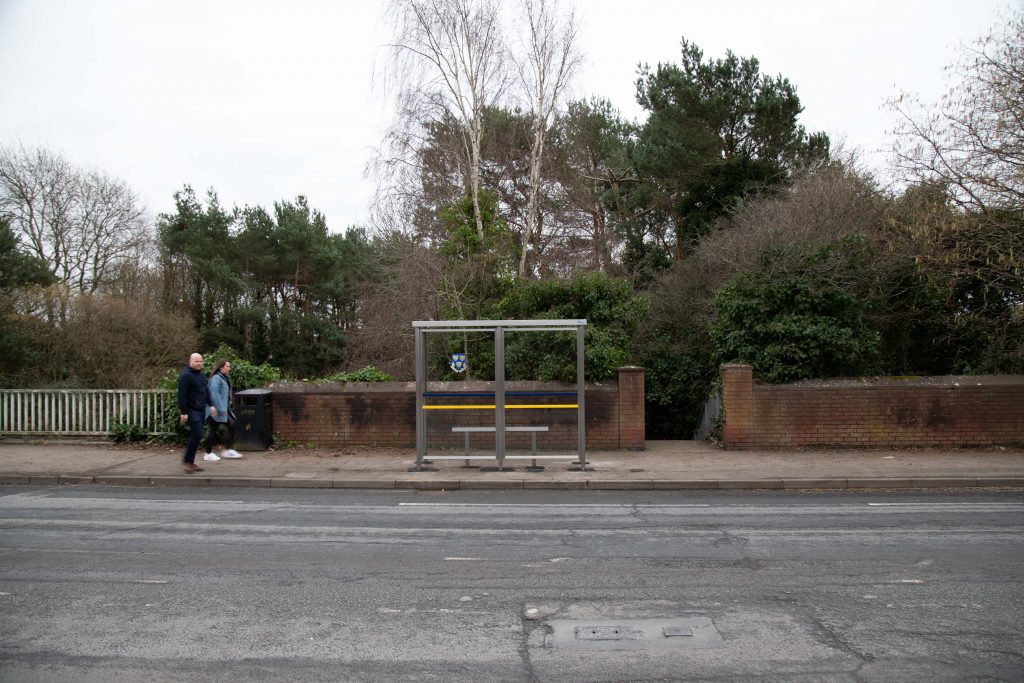
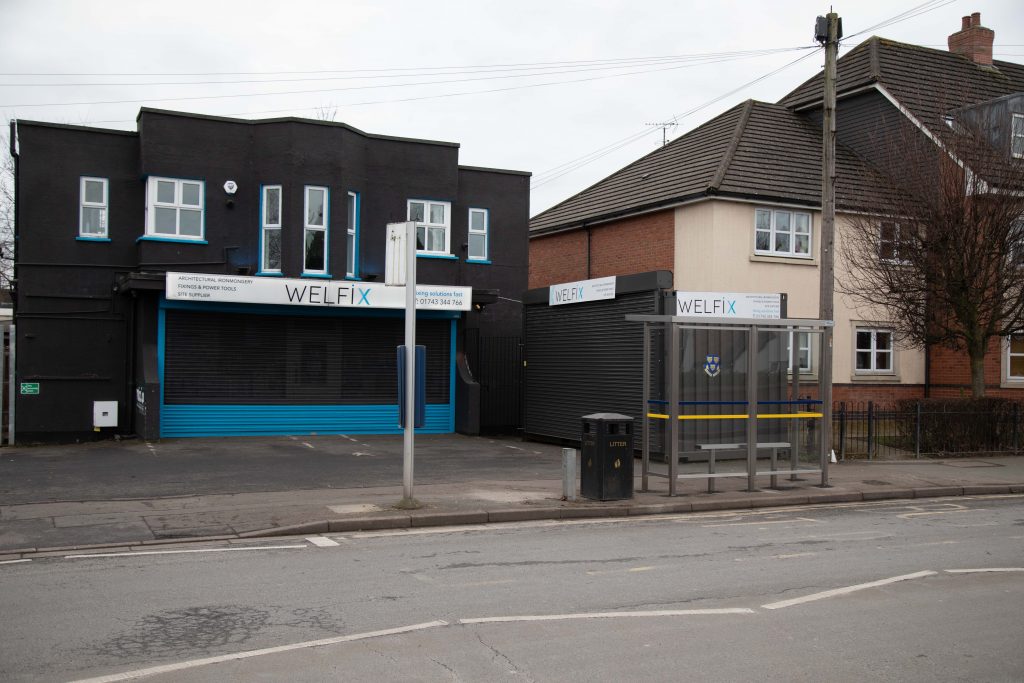
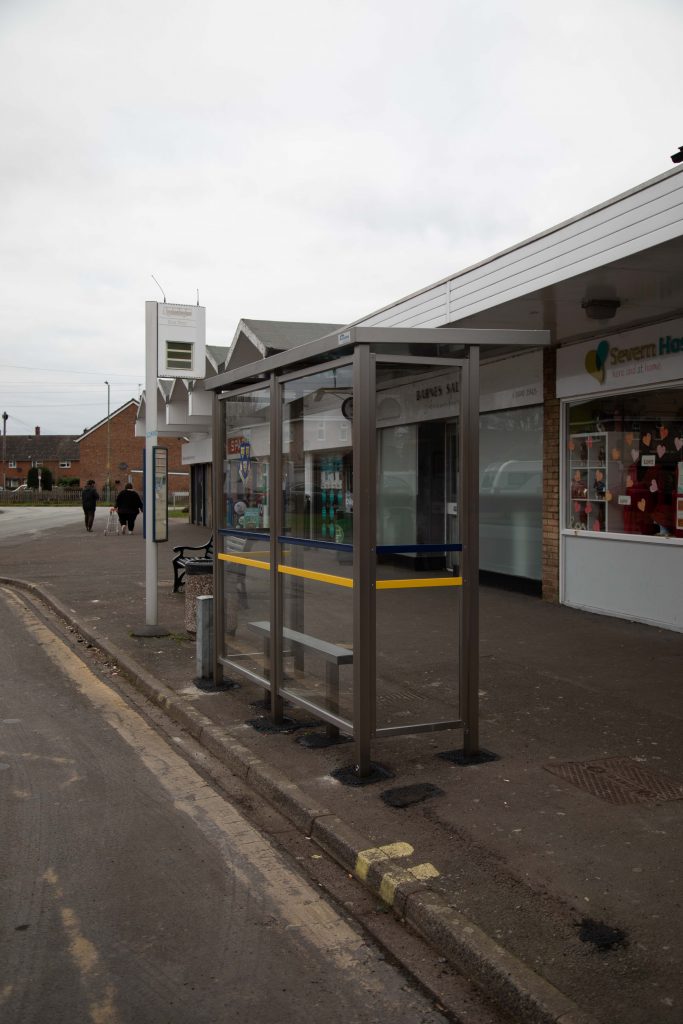
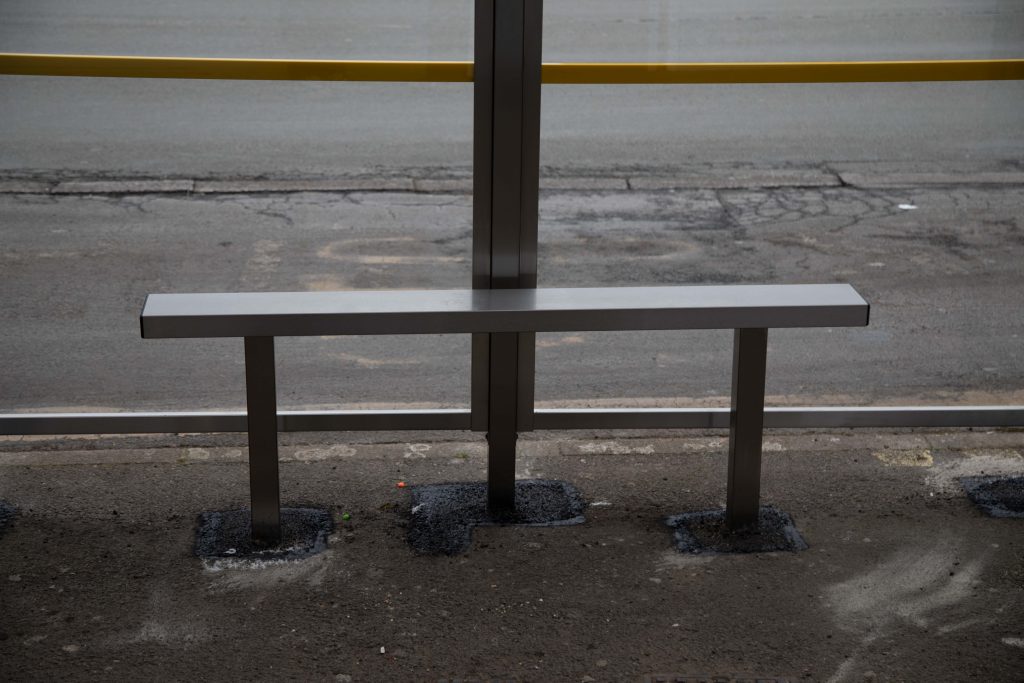
It was important to choose the correct equipment to take with me and I took the already loaded roll of Ilford HP5+ and another roll of Kodak Tri-X as well as batteries and a strap. My digital was mounted with a 24-105mm lens so I could do wide shots and have the ability to zoom in a little as I didn’t fancy standing in the middle of the road to take photos. The lighting conditions meant that this lens was fine but I should have moved the Auto ISO up to a manual 400 as it tried to keep it at 100 and as a result lowered the shutter speed to a 1/60th of a second which gave me a few blurred images.
I had also planned to turn on GPS in my digital camera as I did for the original shoot but forgot once I was on location. Not massively important as I know where these locations are and I’m super familiar with them but ideally I would have preferred to have the geo-locations documented in the images metadata.
Once I’d been in and around the bus stops I explored another old location that I’ve seen in passing but never fully wandered around the grounds. The Whitehall complex in Cherry Orchard, Monkmoor, Shrewsbury is used as a walk in medical assessment centre at present for people who are unable to get a doctors appointment but feel they must be seen quickly. It’s a 1960s office block made up of five floors with lots of glass and metal in its construction. It’s currently available to let too. I walked around the outside of the building looking at the reflections of the surroundings in it’s multitude of reflective windows and took a few photos that might be nice when converted into black and white. I did also use a couple of frames of Ilford HP5 + 400 120 in my Bronica on this building too.
Group Crit
Each of us in the group chose some work that we wanted to receive some feedback on and presented it in a suitable way. I laid out five 10×8 black and white prints of images that had been created from the Ilford HP5+ film that had been dropped previously in a puddle. I also uploaded them to the padlet link we use so it could be seen on the big screen if required.
Once everyone in the class, bar one, had some work to show, we all took it in turns to move a seat to the right, complete some pieces of paper with Positives, Improvement Opportunities and Recommendations.
I found this particularly difficult as there were some classmates whose work was outstanding and I couldn’t find too much at fault, but others whose work I did not connect with but still had to find positives to document. We still had to comment with things that in our opinions didn’t work but to do it in a constructive manner that didn’t overly upset people.
I don’t take criticism badly, I’m used to it after being in the working world for over 30 years, but I do worry that some of the younger members of the group might not be used to seemingly negative feedback. I know some of my friends who are into photography still to this day struggle with anything negative said about their work even though the positives of critical feedback far outweigh the negative aspects of it.
Imagine being surrounded by “Yes Men” all of the time and nobody giving you critical feedback to help you gauge your progress and rein you in if you start going off in the wrong direction.
Once everyone had sat in each other’s chairs and looked at their work, made some notes and then turned the sheet of paper over we all went back to our original seats and investigated the feedback we’d been left.
The pictures of the feedback can be seen in the below gallery:
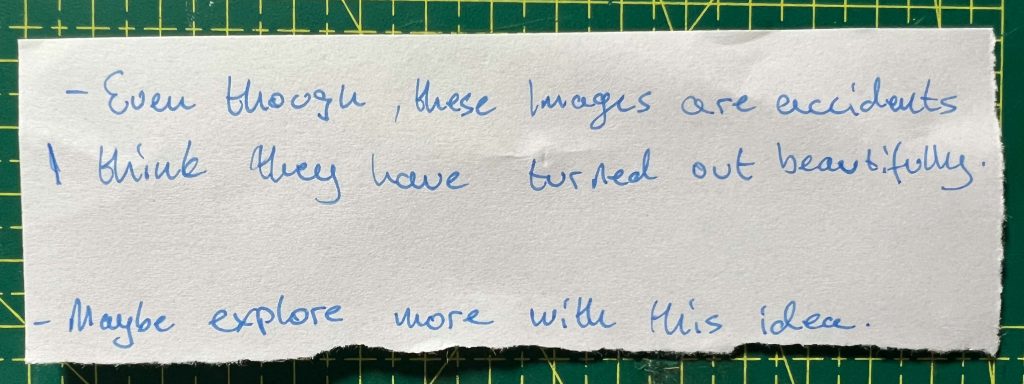
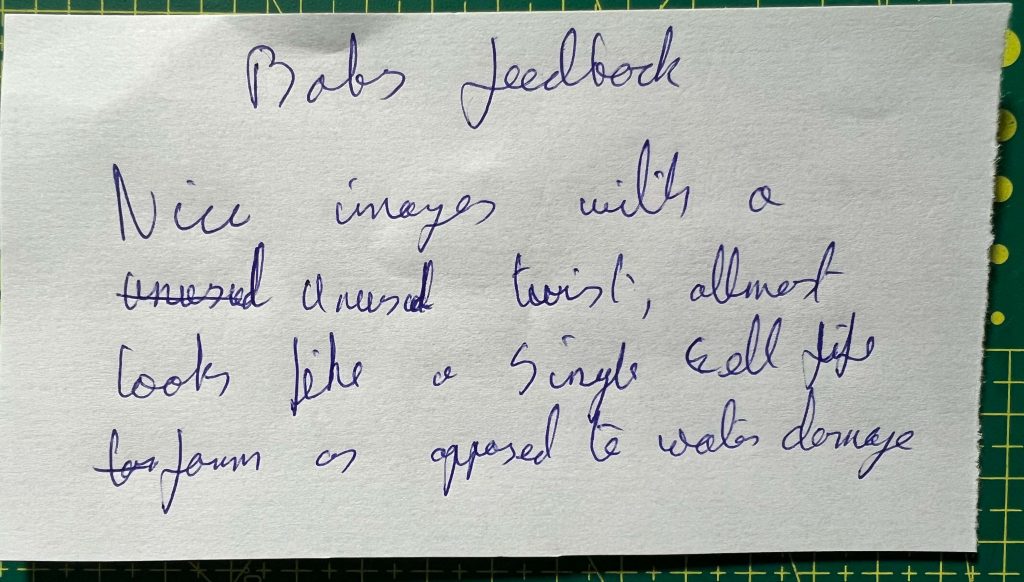
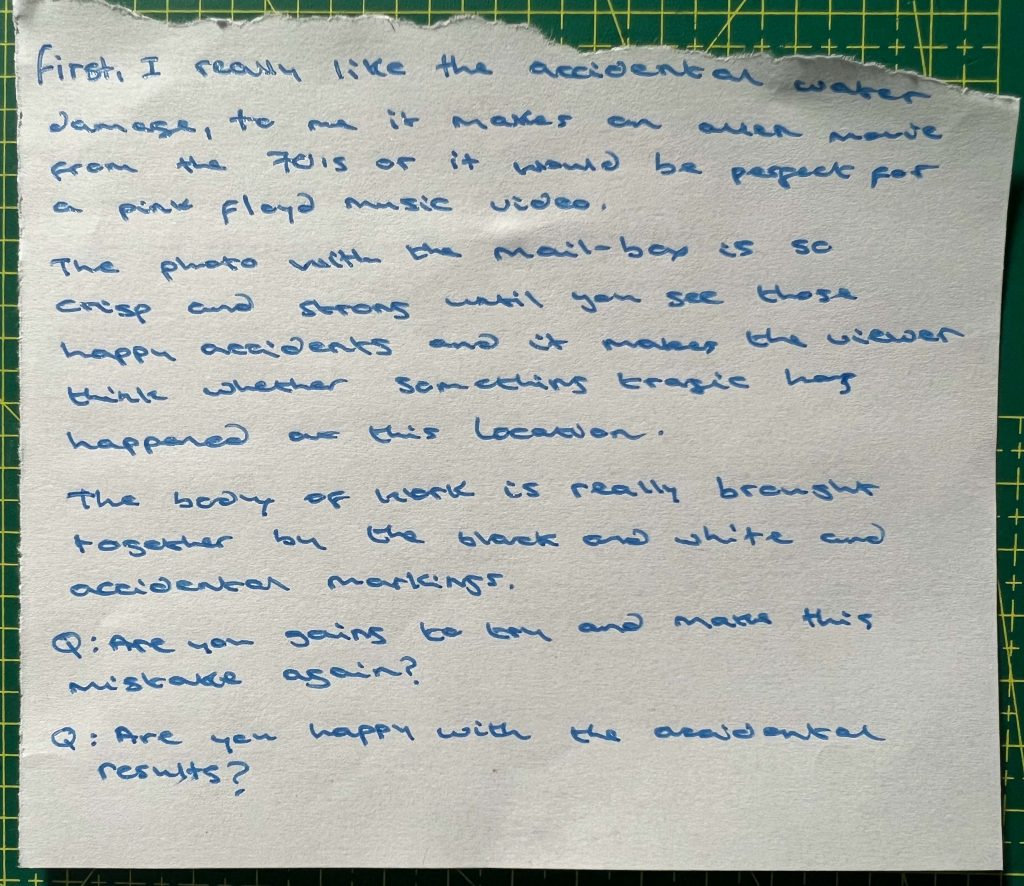
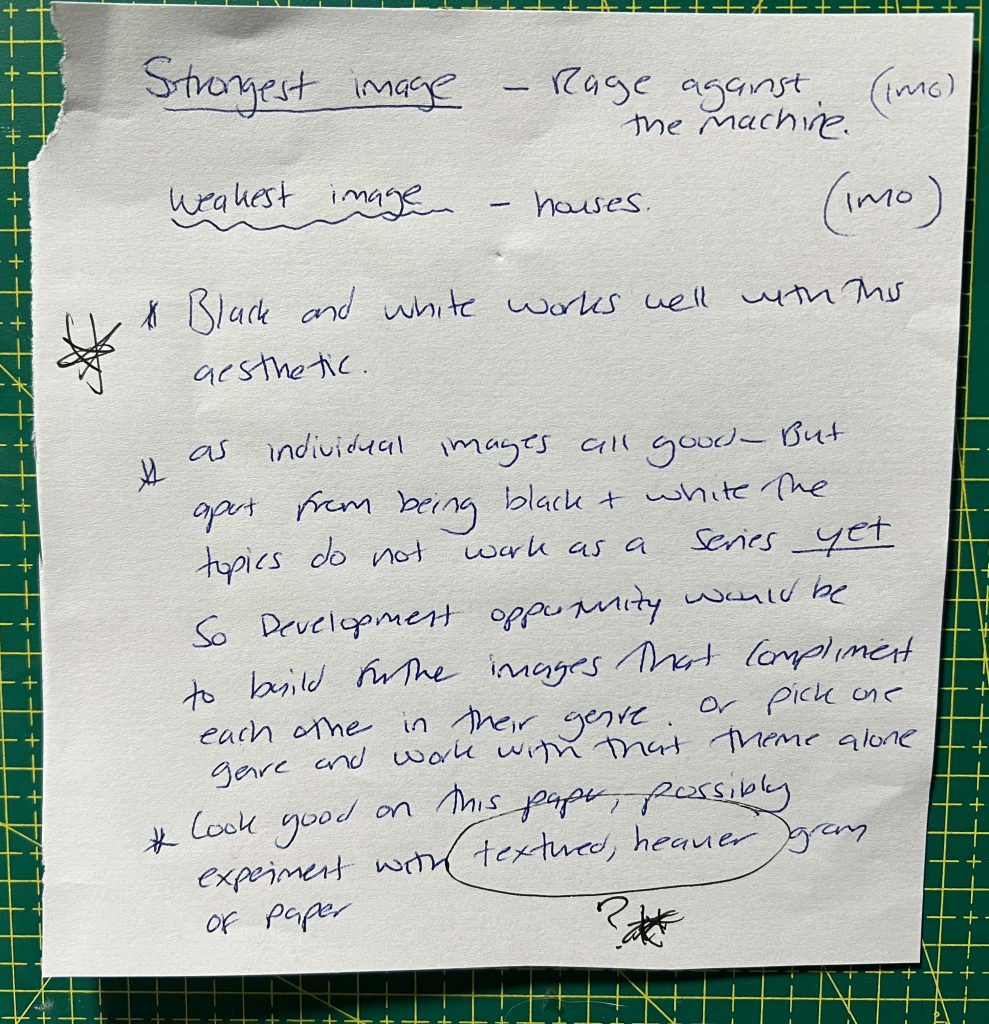

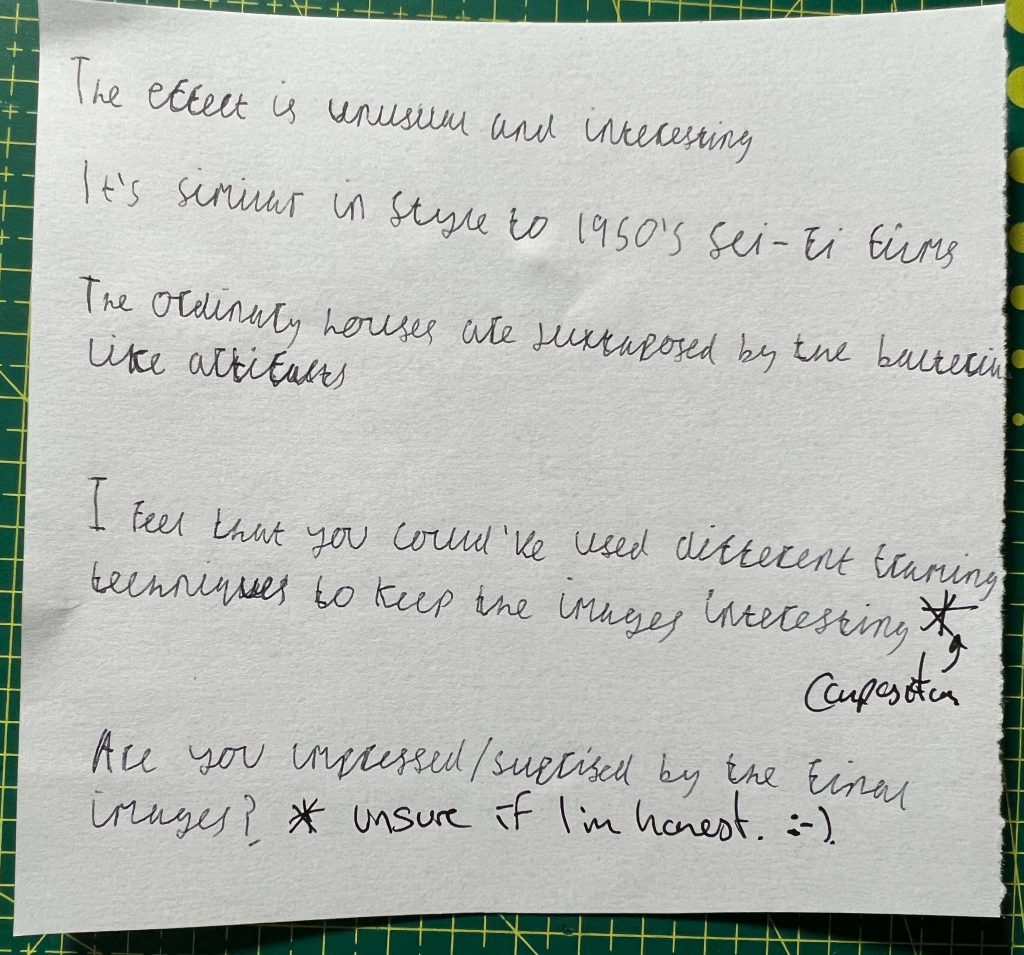
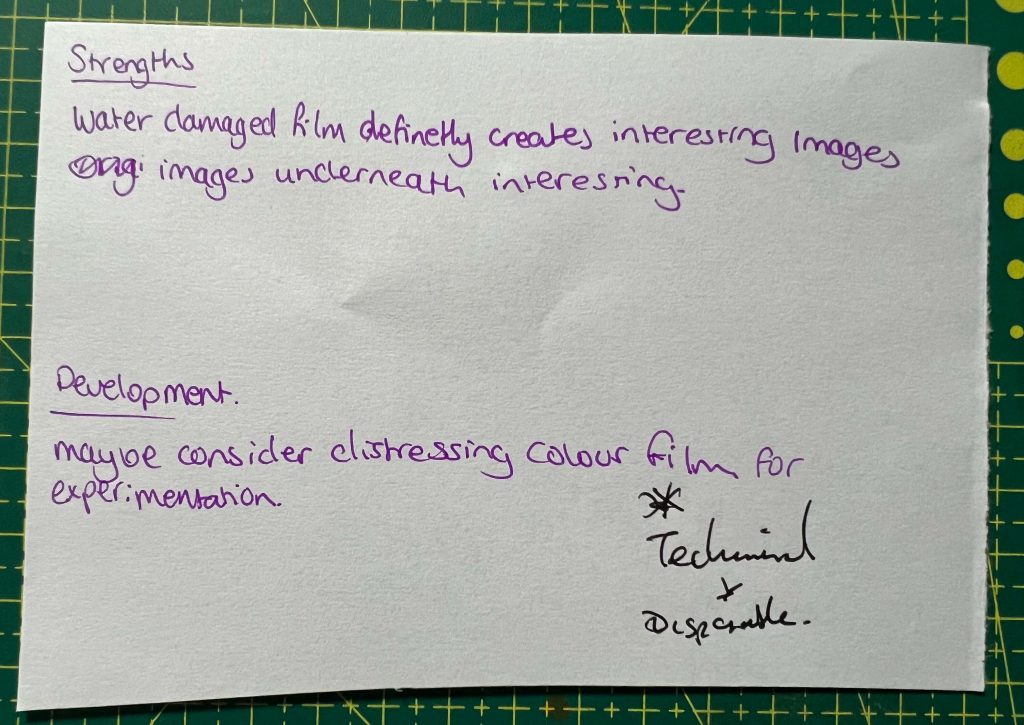
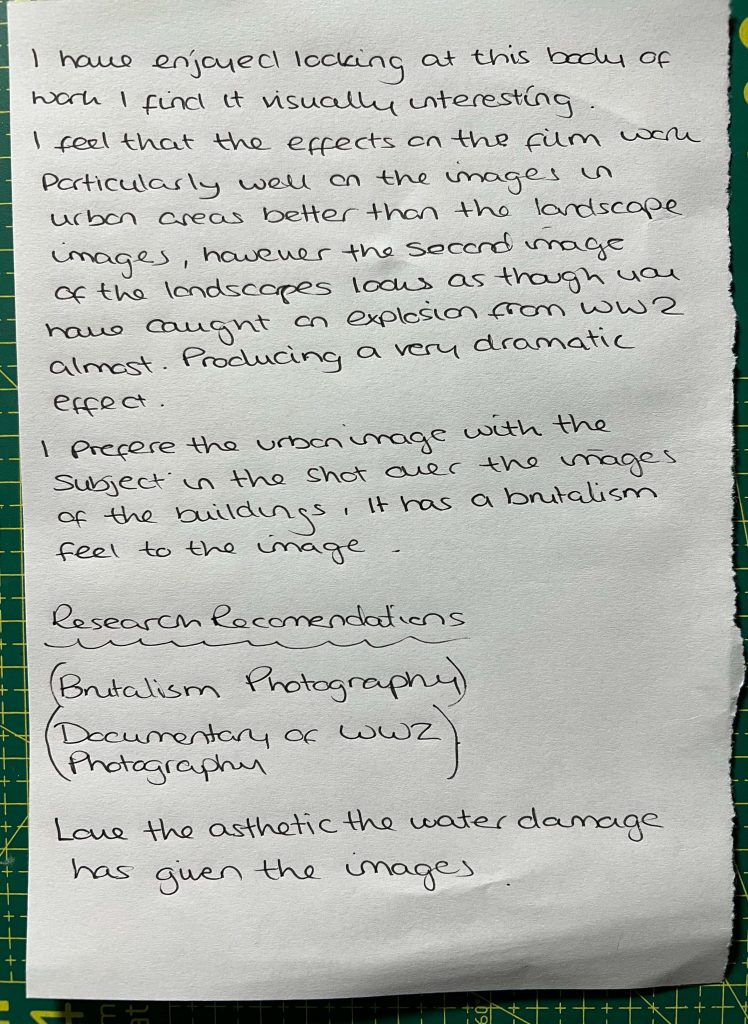
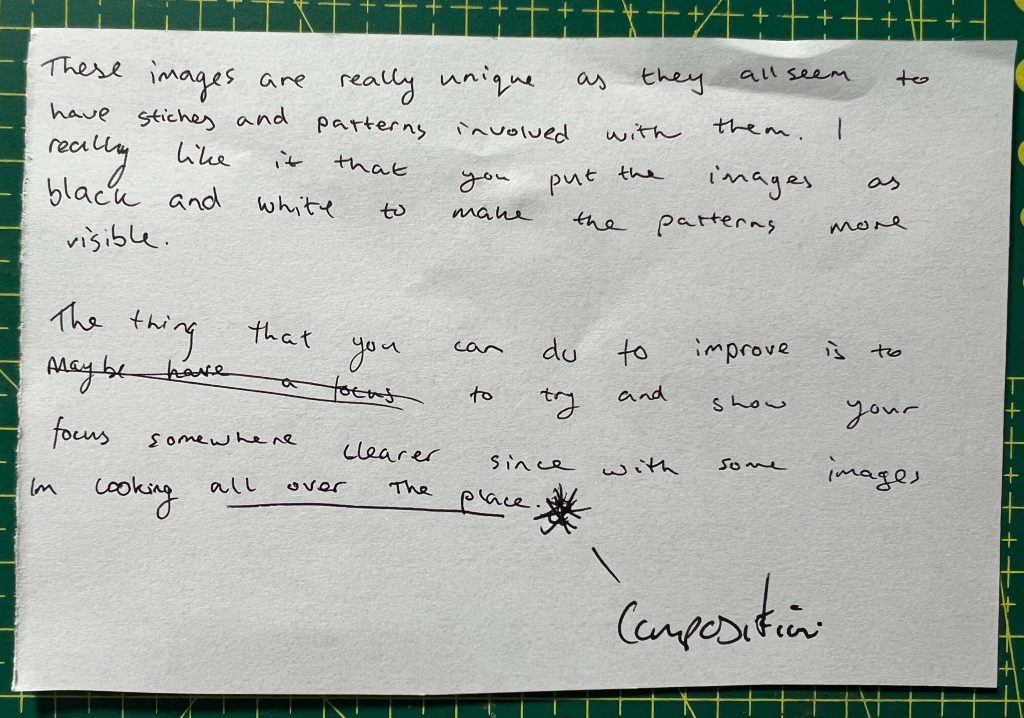
Common themes emerged from my classmates feedback.
| Comment | Tally of mentions |
|---|---|
| Bacteria/Cells | XX |
| Composition | XX |
| Interesting | XXX |
| Urban | X |
| Landscape | XX |
| Damage | XXXX |
| Accident | XXX |
| Series | X |
| Black & White | XXX |
| Colour | X |
| Unusual | X |
| Artifacts | X |
| Single Theme | XX |
| Blurry | X |
| Experimentation | XXXX |
Positives:
You can see from the varied feedback in the images and the table of keywords/themes I picked out it was thought generally that Black & White suited the images presented and the urban images worked better than the two landscapes. Some people liked the water damaged effect and mentioned bacteria/single cell life etc and used words like interesting, Damage and Accident.
Opportunities:
A few of the responses included mention of compositional elements such as it not being an interesting image underneath the damage, it’s a fair point. Would I have chosen the images to print if they hadn’t been damaged ? A couple of people mentioned technical issues such as poor focus on the images and to try and be a bit more careful with enlarging process. This too is a good call as I have in the past neglected to use the Focus Finder after changing the negative in the holder. One of the common opportunities mentioned was to choose a single theme and stick to it. This is a valid comment if the images I presented were designed to be a series, they aren’t but without an explanation or piece of accompanying verbiage there’s no way to know.
Recommendations:
More than one person suggested that I try a similar approach in a colour film which is a good call, but I’m unsure as to how AG photolab would take it if I sent them a colour film that had been soaked in a strange cocktail beforehand. With the new colour film processing ability the Uni has in the studio area it might make it possible to do this. Others recommended that I continue down this path of playing with damaged negatives whilst others recommended that I stick to a single theme and work around that.
Crit Conclusion
Overall I think that this method of critique worked well and it might have been even better had all of the class had some work to show and they were able to share it easily. The almost anonymous pieces of paper allowed people to comment without fear and allowed honesty that might not have been possible had it been a call for verbal feedback in the class.
the feedback I had was useful in that I will consider it when preparing the next shoots for the Year Long Project and the methods of composition etc as well as setting them up in a series.
I also left feedback for my peers on pieces of paper but it proved to be too tricky for some to read, due to my doctors like scrawl on the paper. I found comments in each of the three sections for each person and tried my best to keep it constructive and polite, thoughtful and respectful.
The pictures I shared can be seen in this below gallery.




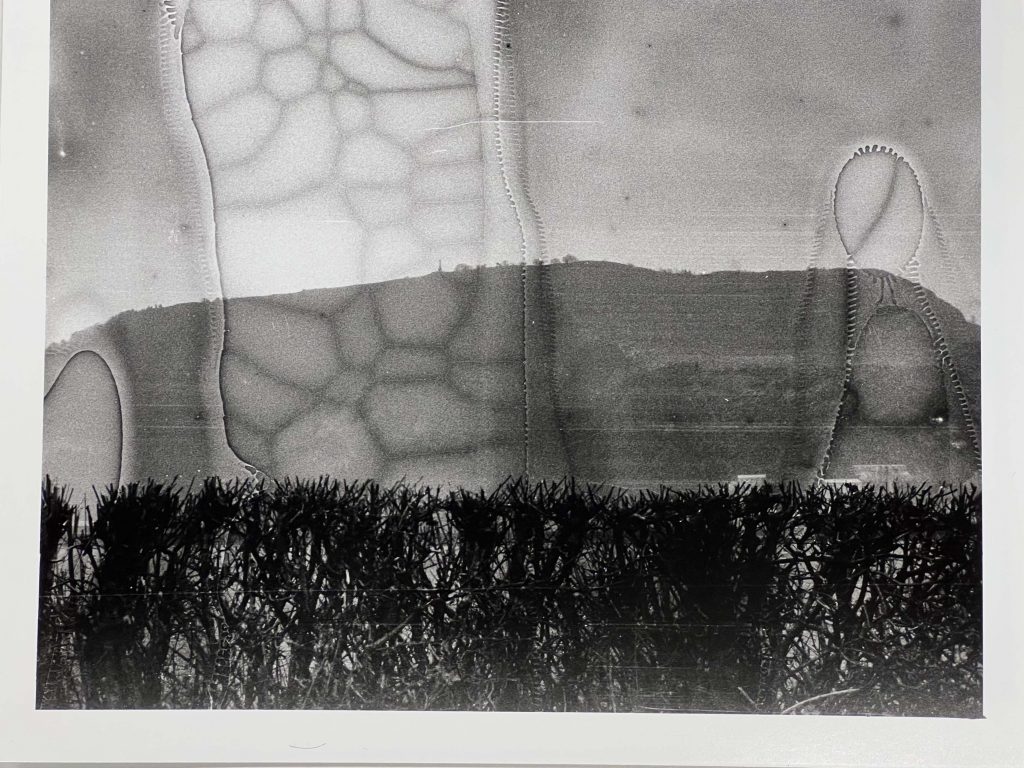
The Riso Printing notes and Reflection will appear in the next post as this one is already too massive to cope with.
Comments are closed.